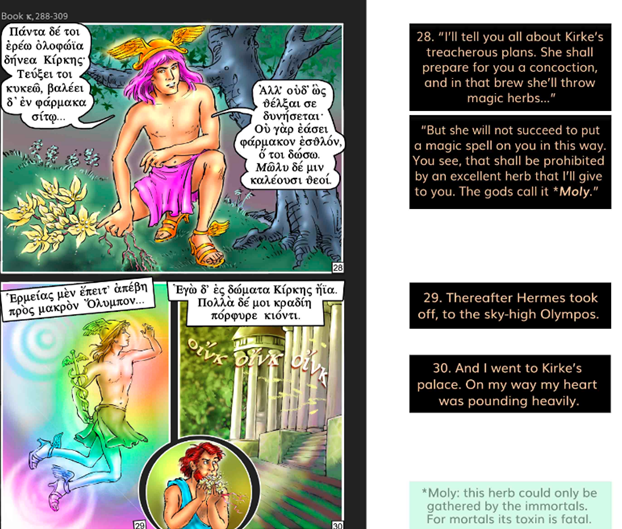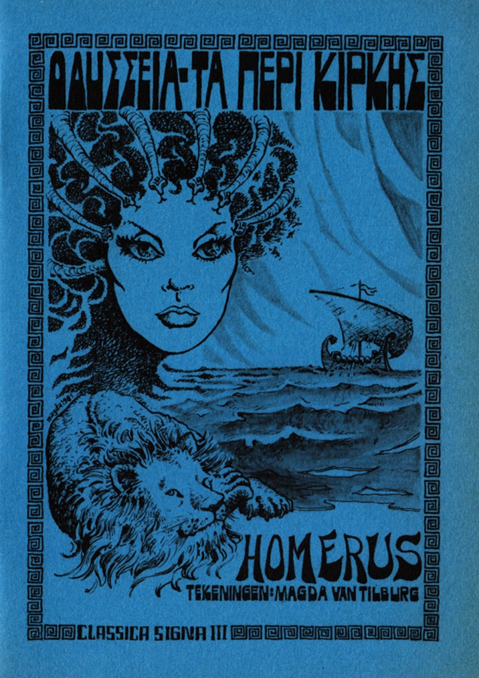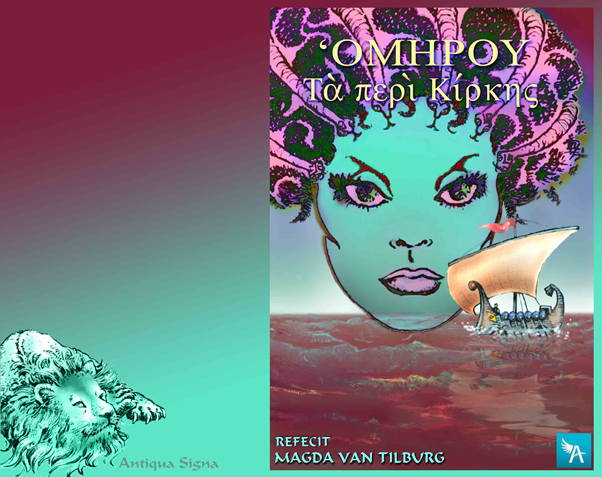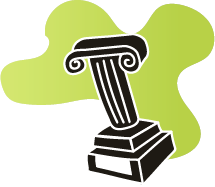Title of the resource
Title of the resource in english
Publisher
Panholzer
Original language
Target and Age Group
Teachers, general public, groups interested in Classics
Link to resource
Accessed on 5 August, 2020
Author of the Entry:
Marta Pszczolińska, University of Warsaw, m.pszczolinska@al.uw.edu.pl
Peer-reviewer of the Entry:
Elżbieta Olechowska, University of Warsaw, elzbieta.olechowska@gmail.com
Second Peer-reviewer of the Entry:
Ayelet Peer, Bar- Ilan University, ayelet.peer@biu.ac.il
Magda van Tilburg
Magda van Tilburg (born in 1954) is a Dutch children’s books illustrator and graphic designer. She studied Classical Languages and Literature at the University of Amsterdam (UvA) and then attended Gerrit Rietveld Art Academy to become an illustrator.
She created a series Classica Signa published by Panholzer - black-and-white cartoons based on classical Greek and Latin texts by Homer, Euripides, Herodotus, Virgil, Ovid, or Plautus. One of them - Dido et Aeneas was displayed at the exhibition Virgil across 2000 years at the British Museum. The series was remade into colour, digitalised and published by C.C. Buchner. It is available online, renamed as Antiqua Signa. After 30 years of her career as illustrator, the author also launched a website booxalive.nl, which promotes reading and the classical languages and contains digital books with illustrations by various authors, including those inspired by Antiquity.
At the moment the author is working on an English translation of Plautus' Curculio (which on booxalive is still in Dutch) and is planning to remake Alkestis by Euripides.
source: nl.wikipedia.org, booxalive.nl (accessed: September 30, 2019)

Courtesy of the Author
Questionnaire
1. Could you describe your experiences in education with Classical Antiquity?
From 1973 – 1978 I studied Classical Language and Literature at the University of Amsterdam (UvA), where I got my Bachelor Cum Laude. After that I went to the Rietveld Art Academy to become an illustrator.
Already in highschool I started to make classical graphic novels with the original ancient texts in the balloons. My first motive was, that I did not have any clue about translations. I always had a big fantasy about what the texts were saying, but in reality the texts said something else. By making drawings of what the texts really said, I could understand better what the stories were about.
With that history, after highschool I chose to study these two magnificent languages, to tame my fantasy and to teach my brain more abstract thinking.
During my university life, I extended my graphic novels to an entire series ‘Classica Signa’, with 8 titles, published by my late ex-husband (4 Latin titles/4 Greek titles).
After a 30-years career as a children's book illustrator I had to stop my studio due to chronic pain. Then I decided to create my own non-profit platform for all kinds of stories, to stimulate the modern youth to read more, and to promote Latin and Greek as fun languages with their immortal stories. So I transformed my titles to digital slideshows, with my translation in English. Now I call this series ‘Antiqua Signa’.
2. What are the language teaching methods and approaches of your choice
I don’t teach.
3. How and why do you choose your target groups?
The many classical orientated groups on Facebook are my main target, since I’m not able to do any active PR due to my health. Those groups include many teachers, and thus my work finds its way to classrooms etc.
4. Why should classical language teaching be paired with mythological education?
That’s the basis of our culture! Those immortal stories have to be kept alive!
5. How do you select the myths and cultural material to be incorporated in your works and how do you present them (do you strive for accuracy, with the cultural background of Antiquity, or do you rather contemporize their form, content or background to be relevant to the target group?)
I chose my titles from the programme I followed at the University. Before drawing each title, I try to research the original settings as well as possible (at the beginning of my work, there was no internet).
6. How do you choose the style of your illustrations that accompany the teaching material ?
I try to make my illustrations look as authentic as possible, with a touch of my own fantasy and humor.
7. Which task types do you employ to consolidate the myths?
With each digital title I also provide a section ‘Fun info’, where I explain some backgrounds of each story/myth.
8. Have you encountered any challenges in finding material on Ancient languages and culture and why do you think is important to popularize them?
I’m so very glad with the internet now and the exploding amount of old and new materials! I think nowadays more people get into mythology, because online there are no borders to get info. Also popular writers like Stephen Fry with his ‘Mythos’ and ‘Heroes’ promote the classics.
9. Are you planning any further forays into classical material?
I still have to translate 1 Latin title: Curculio by Plautus. I also have to redo the last translation, Euripides’ Alkestis. I hope this work will be done in mid-2020.
After that I hope to find a publisher who will produce 2 different volumes of novels (1 book with the 4 Latin titles/ 1 book with the 4 Greek titles).
* Much more about myself you can find on: booxalive.nl ‘in woord’ – I do hope your browser has a translation function…
* Please, feel free to take any image (covers and entire pages) from my site of the classic comic section, since my booxalive is also on a non-profit base!
* On my portfolio site you can find a survey of my children’s books from the last 30-years: magdavantilburg
Prepared by Marta Pszczolińska, University of Warsaw (m.pszczolinska@al.uw.edu.pl).
Contents & Purpose
Kirke is a comic book by Magda van Tilburg, in which she presents the myth of Circe and Odysseus according to Homer. The entire comic is written in ancient Greek, the phrases used by characters come from books X and XI of Odyssey. Some of hexameters and words are omitted or slightly modified producing a more fluent story and lively dialogue. It is only in the digital version that the original text is accompanied by an English translation. In addition to the translation, supplementary blue boxes contain a few explanations referring e.g., to proper names.
The comic first evokes the story of Paris’ judgement and the Trojan War providing an illustration in the style of Greek pottery. The next drawing depicts Odysseus and his ship drifting off from the burning city of Troy with an incipit from the Odyssey ἄνδρα μοι ἔννεπε, μοῦσα, πολύτροπον... [Andra moi ennepe, Mousa, polytropon...]. The exhausted sailors come ashore to the Aeaea island, where lives Kirke, daughter of Helios. She turns most of the crew into swine with human consciousness. Owing to Hermes’ warning and his mysterious herb μῶλυ [moly], Odysseus avoids the fate of his companions and becomes the goddess’ lover. This returns the enchanted men to their human form, making them, due to Kirke’s spell, even younger and more handsome than before. The generous hostess provides them with a prosperous existence on the island. As they wish to sail off to their homeland, she instructs the hero to head to the holy forests of Persephone, and then to Hades where he can ask the shade of Tiresias about his further journey home. Eventually, Odysseus forsakes Kirke and sets off towards his homeland.
The story of Odysseus’ stay with Kirke features not only a powerful enchantress and her romance with the hero. The portrayed world also shows other gods. Hermes (see below), who warns the hero of Kirke’s trick, is shown with his attributes: the caduceus, winged sandals and cap. However, he was given a humorous, modern look with ‘trendy’ pink (resembling Phoenician purple) hair and a waistcloth. Hades and Persephone, whom Odysseus is to address in his prayer over offerings, do not resemble their ancient statues, but rather look like a married couple with an unusual dog (see below). However, Hades also becomes a sombre incarnation of the Underworld (see below) who seizes Elpenor into his kingdom when the hero forgets to use the ladder and falls from the roof breaking his neck. The comic also in a remarkable way evokes the story of the quarrel between Athena, Hera and Aphrodite over the title of the fairest and the judgement of Paris and its consequences. It is represented only by a single suggestive drawing in red-figure pottery style, which contrasts with the vibrant colours and modern execution of the other drawings. The ancient style suggests that the reproduced scene took place earlier, providing the origin of the story.




Courtesy of the Author
Addenda


Covers courtesy of the author


